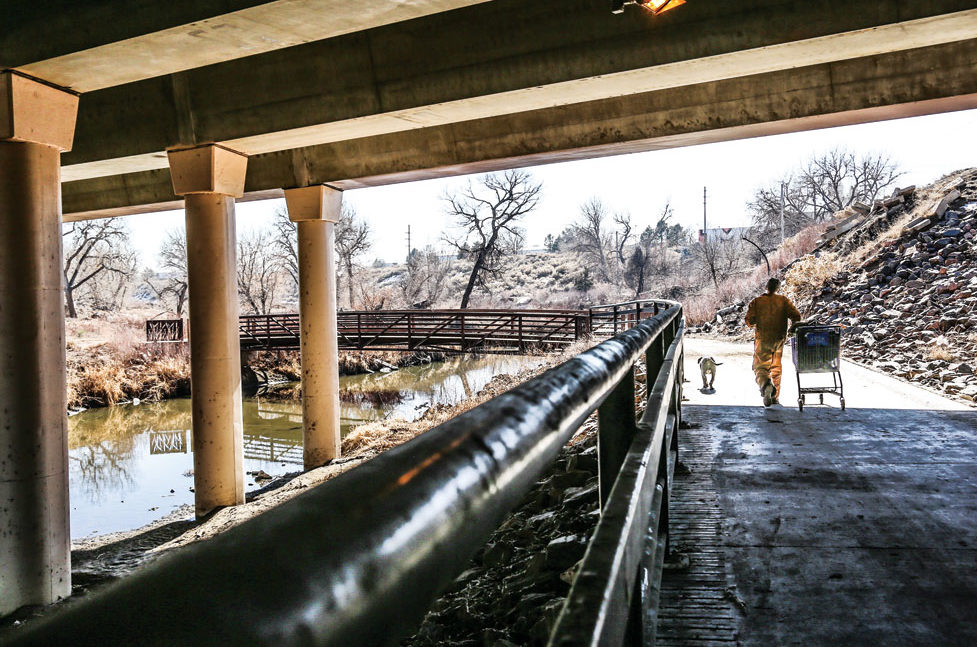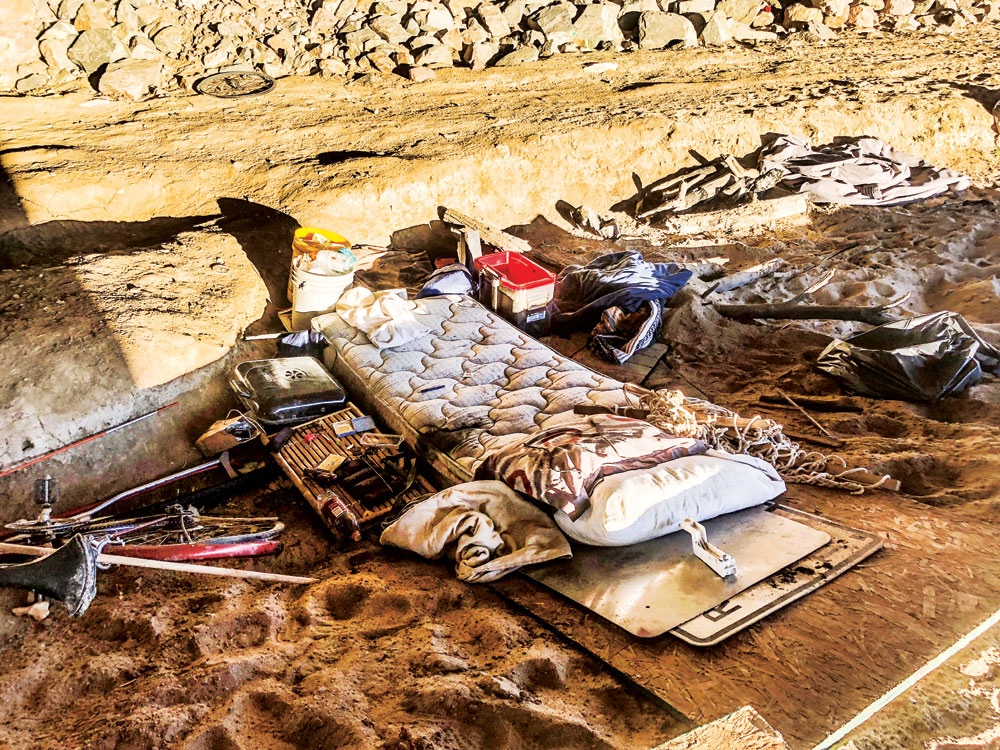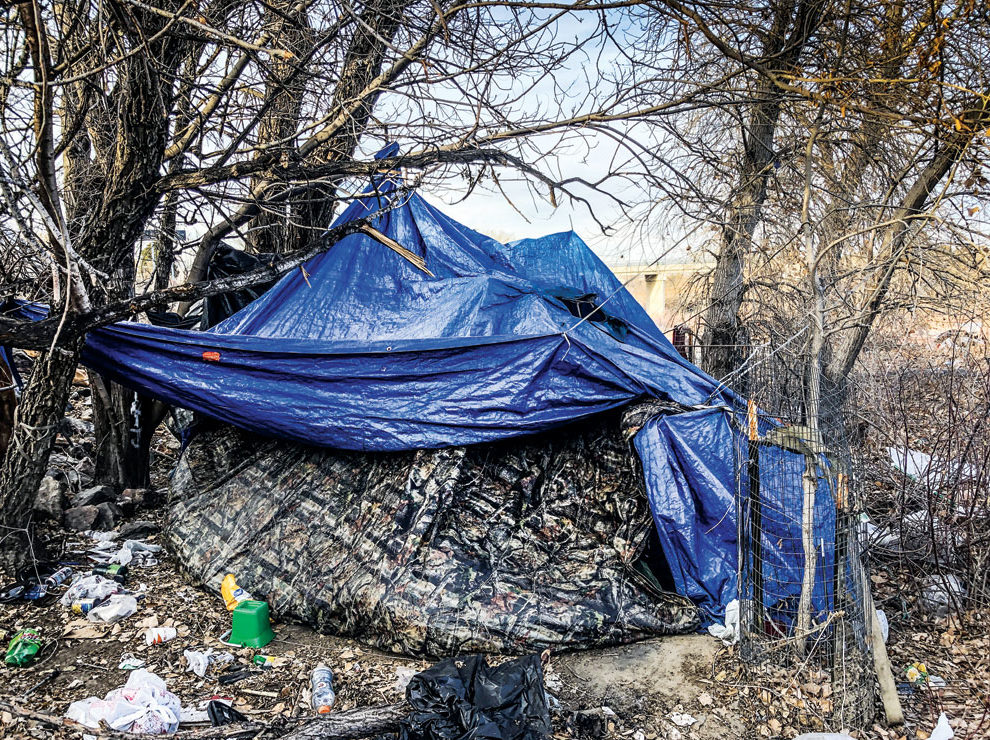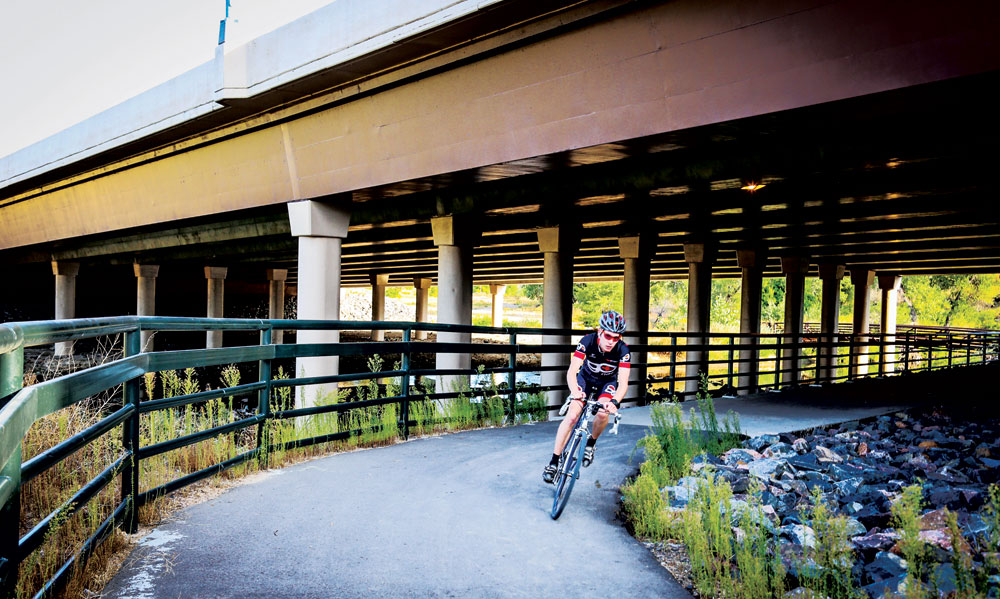
A homeless man walks his dog along the Sand Creek Trail at the I-70 bridge.
A 14-mile open space trail for cycling, hiking, birdwatching and even horseback riding is a luxury in an urban neighborhood. Northeast Denver residents who love the outdoors are lucky to have the Sand Creek Greenway and Trail close by. But this recreational amenity has long been a popular site for those who are homeless. Though camping in the Greenway is prohibited, people experiencing homelessness have traditionally been able to live there fairly discretely. Development and population growth, however, have changed the dynamics. According to District 5 Denver Police Lieutenant Kevin Hines, “The city has come to the homeless camps rather than the camps coming to the city.”

A Sand Creek Trail volunteer took these photos of homeless persons’ belongings found along the trail.
Initiative 300: Urban Camping
In May, voters will see Initiative 300, the Right to Survive, on the ballot. The question is whether urban camping should be allowed under Denver’s Municipal Code. The current ban that began in 2012 makes it illegal to use “blankets or any form of protection from the elements other than one’s clothing.” Opponents of the ban contend it criminalized homelessness. Central to Initiative 300 is its guarantee within the City and County of Denver of “the right to rest and shelter oneself from the elements in a non-obstructive manner in public spaces.”

A Sand Creek Trail volunteer took these photos of homeless persons’ belongings found along the trail.
“If this ballot measure passes, it will make it impossible to enforce specific ordinances and Denver Park Rules & Regulations,” according to an email from Scott Gilmore, Deputy Executive Director of Parks and Recreation. “These include curfew, trespassing in closed areas, erecting of tents and other structures, managing permitted events, and public health and safety issues that impact all citizens of Denver.”
Rights of Homeless People
Longtime activist Terese Howard, who is part of the nonprofit advocacy group Denver Homeless Out Loud that is behind Initiative 300, appreciates people’s concerns relative to urban camping, but counters, “The reality is people do that [use drugs, own weapons, etc.] if they live in houses or tents or shelters or anywhere. There are people with real problems who are dangerous and people who struggle with drugs, but the big issue here is that we as a society have decided that… it’s somehow different if it’s someone who’s homeless who is doing those things versus someone with a home. The fact of their homelessness doesn’t make it any different, except that they have to do it in a public space.”
“Homeless Whack-A-Mole” or Comprehensive Solution?

A Sand Creek Trail volunteer took these photos of homeless persons’ belongings found along the trail.
The Sand Creek Trail encampments represent a microcosm of what takes place across the metro area, with each new evacuation and cleanup simply moving the encampments to a new location. As people relocate in response to their eviction, the burden of cleanup shifts from one jurisdiction or agency to another, creating a sort of “Homeless Whack-a-Mole,” as Howard terms it.
The crux of the issue is the need to create solutions for our growing homeless population so that camping is no longer the most viable option. Commerce City’s Emergency Manager Kirk Dominic observes “We need a comprehensive regional strategic plan combining local, county, state, and federal resources and dedicated outreach teams to provide a coordinated approach to the problem, with options for people with different needs.” He cites the example of cities with sanctioned encampment areas that provide sanitation services in a controlled space as one possible approach. Shelters with daytime hours, tiny homes and more affordable housing may represent other elements of a solution.
Dominic emphasizes that these efforts must be regional to be effective, and not place an inordinate burden on any single municipality. In the end, a comprehensive regional approach with pooled resources might cost taxpayers about what is now spent on the combined efforts of law enforcement and others while offering a more humane and dignified way of life for people experiencing homelessness.

A bicyclist passes under I-70 on the Sand Creek Trail.
“That could be my mom or dad, my kids,” Dominic says. “I have talked to a lot of the people I meet along the Sand Creek Trail and elsewhere, and in hearing their stories it is clear that one major medical issue or job loss is all it takes. Most of us are just a paycheck or two away from living out of our cars. It’s a complex problem with economic, social, and political dimensions. We need an approach that balances people’s dignity with public health and other considerations.”
Maintaining the Trail for All
In most cases now, law enforcement is called in to clean out an encampment after receiving reports from park rangers or community members. Colorado Department of Transportation’s (CDOT) Superintendent for Region 1, John Lormé, says his agency works closely with other stakeholders to humanely address these calls. “We don’t come in like Stormtroopers.” People receive 7 days’ notice of their eviction, and at this point, advocacy groups, DPD’s Homeless Outreach Team, and law enforcement try to connect them to appropriate resources. Each of the representatives from these different agencies emphasize that they prefer to connect people with resources rather than fine or arrest them. Unless someone is engaged in criminal activity or has an active warrant, police will refer them to service agencies. “It’s not illegal to be homeless,” Hines affirms.
By the time law enforcement returns 7-14 days after serving notice, the camps have usually been evacuated; however, the resultant cleanup is time-consuming and expensive, requiring protective gear to retrieve used syringes and collect human waste, and multiple dump truck trips to remove garbage and biohazardous materials.
Lormé has a staff person dedicated to homeless camp cleanup who coordinates CDOT efforts with six metro counties. “You really feel bad because many people are not there by choice,” he says. His mission, however, is to maintain highways, bridges, and other transportation resources. “My budget for maintenance today is the same as it was in 1992 under my predecessor, but cleaning up the encampments is taking a larger portion of it each year.” Though he would prefer to spend all of his $37 million annual budget on maintaining roads, bridges, and other CDOT priorities, Lormé spends $3.2 million a year removing trash and debris from the highways, including cleaning up homeless encampments.
Beth Nobles, Executive Director of the Sand Creek Regional Greenway Partnership, would like all residents to be able to use and enjoy the trail, and describes its puzzle-like composition as part of the challenge in enforcing existing laws. Multiple entities, including Denver, Commerce City, Aurora, CDOT and Brookfield Asset Management (new owner of Forest City properties), own the land that comprises the trail corridor. The complexity of the trail’s ownership makes it difficult to get a handle on the scope of the camping issue and its attendant environmental and other risks.
When asked about possible solutions, Howard says “The answer is not to do what cities have considered a solution—pushing folks around from place to place like a game of Homeless Whack-A-Mole—which is completely ineffective.” Ticketing people and relocating them periodically means “they’re just moving people and their associated needs from one area to another. We absolutely need to address those concerns; we need to add trash cans and clean the areas in a dignified way like anyone living in a house gets… chasing people further away and telling them they can’t exist doesn’t solve the problem.”
Nobles and Hines ask that community members who see something of concern like trash, graffiti, or fire hazards, call 311. Hines also suggests calling the station at 720-913-1400 or the non-emergency line at 720-913-2000. For the complete text of the ballot initiative, go to: https://www.denvergov.org/content/denvergov/en/denver-elections-divison/campaign-information/initiated-ordinance-process.html.


Terese Howard absolutely should be REQUIRED to watch this documentary. Sometimes compassion is misdirected and causes more harm than good to those you are trying to help. Denver needs to learn from Seattle! https://komonews.com/news/local/komo-news-special-seattle-is-dying-03-21-2019
And the 9th circuit has decided for Seattle that such laws are unconstitutional. They reiterated it with another ruling yesterday.